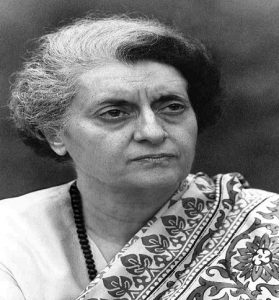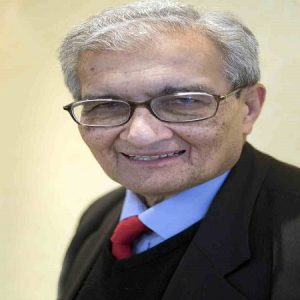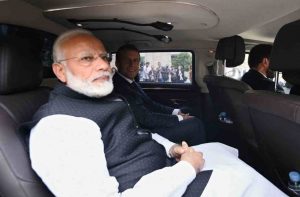
An introduction to and review of a new, yet-to-be-released book on the controversial subject
~By HK Dua
Prime Minister Narendra Modi, like Indira Gandhi much before him, has a flair for making surprising and dramatic moves to shake the country out of the mundane and the routine.
Way back in 1975, Indira Gandhi shocked the nation by clamping emergency on the country, violating the Constitution, usurping the powers of Parliament, the Judiciary and the Executive, and suspending the fundamental rights of the people including the right to life and freedom of expression.
The move Narendra Modi had recourse to on the evening of November 8, 2016 was equally drastic. He called his colleagues, ordered tea and snacks for them, made them feel comfortable and himself rushed out of the Cabinet Room to make a broadcast to the nation. The countrymen, like his ministers closeted in the Cabinet Room, were stunned by what they heard from him. The prime minister had simply declared that from then onwards, the Rs 500 and Rs 1,000 notes in their kitty were no longer legal tender. The sudden announcement by the prime minister had the impact of an edict for the people all over the country—the rich or the poor, the young or old, housewives or office-goers—the people in every home or hamlet. The prime minister’s announcement made people wonder whether they were living in their own country where they had only recently been promised ‘Achche Din’.
In one blunt stroke, a sort of surgical strike with no ifs and buts involved, Prime Minister Modi had pushed a great democracy like India into the company of such nations as the erstwhile Soviet Union when its economy and political structure were collapsing, North Korea, the junta-ruled-Myanmar, Nigeria, Ghana, Iraq, and Zimbabwe. Not one democratic country has ever opted for demonetization as a cure for its economy.
Scores of reputed economists across the country, such as Amartya Sen, Kaushik Basu, and Dr Manmohan Singh, wondered why Narendra Modi had made a decision that no democratic country had dared to take, particularly when India’s economy was growing at about 7 per cent—one of the highest in the world.

Most banks and markets were closed for the night. The people in the cities and small towns rushed to ATMs, but soon, they ran out of low-value cash that they could use to buy veggies and milk. Long queues began forming in front of banks and ATMs in the early hours; people wanted to draw whatever little cash they could get to buy their daily needs. In the long queues, anxiety, uncertainty, shock, and anger reigned. ‘Why did he do this to us? We had voted for him, not for this,’ were the kind of comments heard in the long queues as the full impact of the most vital decision Modi had taken in the middle of his five-year term began to unravel.
Modi had set out four major objectives for his decision for which he personally took responsibility—to tackle black money, corruption, counterfeit currency, and terrorism. He admitted the decision would cause hardship and pain to the people, but said it was necessary for tackling black money hoarded by those who were thriving, sitting as they were on their huge stocks.
In the long queues, there were doubts, some murmurs of protests, sharing of daily experiences but, luckily, not much violence. Somehow the poor began believing that the prime minister had hit hard at the black-money hoarders, corruption, and terrorists. And that he was working for the poor with courage and conviction.

The ruling party MPs and MLAs—unsure of public mood for a few days—were hesitant in going to their constituencies to take the prime minister’s message and explain the decision, but those who suffered in the long queues chose to bear the pain for the nation’s sake. Many economists and opposition leaders, the rank and file, were critical and were certain that none of the four objectives Modi had spelt out would be achieved.
In the long queues, broadly, there were two kinds of people. Those with their savings at home in Rs 500 and Rs 1,000 denominations and those who wanted to draw some rationed cash from the banks or ATMs. Often, they didn’t have enough cash to dispense—not even the promised Rs 2,000 or Rs 4,500. Those who had come to draw their own money from their own account felt like beggars! Those who came to deposit their mother’s or grandmother’s piggy bank savings in higher denominations felt like criminals for holding on to some ‘illicit’ cash, even if the grandmother had been saving it in bits for an emergency, for unforeseen family needs, and had not crossed the limit of Rs 2.5 lakh announced by the government.
Months later, the evil of black money doesn’t seem to have been eradicated. No property developer has been hauled up by the authorities; money-based politics is still as rampant as corruption. There is no let-up in terrorist attempts to unsettle India either.
When the desired results were not achieved, the government smartly shifted its focus to creating a digital economy in place of the cash economy. It is, however, easier said than done! No country in the world has been able to abolish cash from the economy. In a country like India with a large chunk of population unable to access the internet and the gaping digital divide that exists, it will take a long time to replace cash with plastic money.

With less cash in the market, already local barters are becoming a daily practice in the villages and small towns. Worse, the village mahajan, who for centuries had exploited the poor, has come back in business in the countryside. The inspectorate is becoming dominant again, with greater powers to harass the honest citizen. The rich, the bold, the mighty, and the resourceful can even now get away with impunity. The nexus between an over-smart inspector, traders, and property brokers is visible once again.
Demonetization is not free from the law of diminishing returns, which seems to have already set in. The drive for digitization of the economy may suffer because the digital divide will remain acute for some decades, given the reach and quality of our education system.
The worst damage demonetization has done is to the job market, particularly in the informal sector—from Mayapuri in Delhi to Tirpur in the deep south, thousands of workers lost jobs as also in Ludhiana, Ghaziabad and Kanpur. In small-scale industries and in the grain mandis, in the absence of work, labourers had to leave for their villages, which in any case didn’t have employment to offer.
As of now, the government has not come out with figures of how many people lost their jobs as a result of demonetization and how many have come back to the workplace. Moreover, there are no figures available about how much black money was deposited by people in the stipulated 50-day period for depositing the old currency.
Prime Minister Modi’s decision to go in for a desperate remedy of pulling out 86 per cent of cash from the hands of the people was bound to set off a fierce debate over the pluses and minuses of demonetisation. The debate was not confined to the long queues but also raged at roadside dhabas, in the drawing rooms, in the bazaars, and in the posh shopping malls. It also became the subject of animated discussions among the economists, political scientists, and the India watchers all over the world.
Palimpsest decided to join the debate through this volume—shining a light on all sides of the issues involved. The book contains serious articles—for and against—aided by the perspective gained after the dust had somewhat settled.
The case for demonetization has sought to be demolished by Prof. Arun Kumar, the noted economist who has written two books on black money. There are essays by Prof. Zoya Hasan, the political scientist who sees demonetization as a weapon Narendra Modi has used to achieve his political aims. Sitaram Yechury of the CPI(M) is as severely critical of demonetization in his piece as he was in the Rajya Sabha. They all believe that Narendra Modi has not achieved what he wanted to by what he thought would be a historic triumph for the national economy. Manish Tewari of the Congress party quotes chapter and verse to contend that demonetization violates the Constitution.
The case for demonetization has been made by Anil Bokil, chairman of ArthaKranti, a Pune-based pro-RSS economic think-tank. He has been campaigning for a long time for demonetization, even when Narendra Modi was the chief minister of Gujarat. His scheme—he calls it remonetisation—somewhat resembles the announcement the prime minister made on November 8, 2016. Anil Bokil is backed by noted economist Bibek Debroy and the railway minister Suresh Prabhu.
Sunanda K Datta-Ray, in his delectable essay, captures the flavour of the debate as of a Kolkata adda, where the most vital issues evoke arguments mixed with passions. Economic commentator N Chandra Mohan tries to prove how flawed was Narendra Modi’s decision on economic grounds.
The jury is still out on whether such a widespread disruption affecting 1.3 billion people was at all necessary, with so little gain for the country!
—The writer is a former editor, media adviser to the Prime
Minister, ambassador and Member of Parliament. At present,
he is Adviser in the Observer Research Foundation


